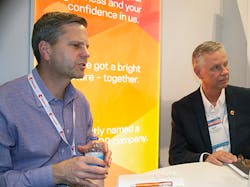Chemours Strives to Ensure Contractor Refrigerant Readiness
On February 3, Day 1 of the 2020 Air Conditioning, Heating, and Refrigeration Expo at the Orlando Convention Center, The Chemours Company announced the successful installation of Opteon™ refrigerant at Pepsi Center, home of the Colorado Avalanche®. Opteon™, the official refrigerant solution of the NHL®, is a sustainable, reliable and cost-effective refrigerant offering for ice refrigeration chiller systems. Trane, one of the world's leading heating, ventilation, air conditioning and cooling (HVAC) equipment manufacturers, provided the turn-key chiller solution for the arena's rink operators.
Chemours sources report that Opteon™ refrigerants provide an optimal balance of performance, safety, and cost efficiency compared to other alternatives, while providing sustainable solutions for ice rinks.
Chemours sources report that Opteon™ refrigerants provide an optimal balance of performance, safety, and cost efficiency compared to other alternatives, while providing sustainable solutions for ice rinks. Opteon™ XP10 (R-513A) refrigerant is a non-ozone depleting potential, low global warming potential (GWP) refrigerant for new equipment and retrofit of existing systems. As demonstrated by the successful chiller conversion at Pepsi Center, Opteon™ XP10 offers an excellent cooling capacity and energy efficiency match for R-134a that is easy serviced and environmentally sustainable.
In other news released prior to the AHR Expo, Chemours reported that the state of New Jersey would begin proceeding with the adoption of the Environmental Protection Agency’s SNAP HFC refrigerant phasedown program. Exact dates of the phasedown are forthcoming. Find that story and a Chemours phasedown chart online, HERE.
Contracting Business spoke with Chemours refrigerant experts during the AHR Expo, to gain insight into how the company is communicating with HVACR contractors to help them through the coming refrigerant developments: Allison Skidd, marketing manager, Opteon™/Freon™ fluorochemicals; Joe Martinko, business director – Americas for Opteon™/Freon™ fluorochemicals; and Jeff Warther, HVACR training and business development manager.
CB: Contractors often feel all they can do is wait for information related to when they must stop using certain refrigerants, and the best options. How do you advise contractors regarding making a refrigerant decision now, and assuring them what you’re offering will be in step with future refrigerant mandates?
Jeff Warther: “When a contractor is selecting a refrigerant, the information is often coming from the distributor. So, we work to help inform distributor counter employees as well as the industry as a whole, at industry events and other forums, of key industry changes and refrigerant information. During training sessions, some contractors have told me, ‘well, we finally switched over to R-410A.’ And I have to tell them that R-410A was introduced in 1992.
'Training is critical. Contractors often express feeling uninformed, and we have to change that. We have to provide the information through webinars or one-on-one discussions, because, what they don’t know, worries them, and we don’t want that.' — Jeff Warther
Joe Martinko: “As we work with our distribution partners, we go out into the field with them. We have business development trainers who work down the value chain with their customers. That’s an area in which we’re trying to expand, so we can provide that service as we go forward.
“Chemours actually began development on its comprehensive Opteon product line back in 2006. This included making the determination of how to apply it in mobile air conditioning applications, commercial refrigeration or stationary air conditioning applications. We had to determine what type of product line we could offer that would meet the needs of contractors in those various segments, well before the industry was ready to transition, and before the newest EPA regulations were in place. Today, as the state and proposed federal regulations move forward, we can understand them with some level of confidence, so we can conduct training and provide information broadly.
“Chemours believes we have the right portfolio in place. And now we move forward to work with various industry players, to help them work through the transition. We have traditional sales channel reps and also technical service and other business development to answer any questions and educate end users.”
Jeff Warther: “We have a ‘Tech-to-Tech’ phone line, and it’s amazing to hear some of the calls we receive. Those calls often become training sessions. It’s still very much a grassroots effort. When people call in it’s because they really need answers, and that’s good. We have information to give them. And if the information is coming from the refrigerant producer, they trust it, because there’s lots of incorrect information out there that we have to set straight.
“It’s a journey. The NHL®-Opteon™ partnership for ice rinks is one step of the way, and we’re still trying to bring along the other segments as regulations impact them.
“I see these refrigerant transitions as opportunities to reconnect with the contractor community. We worked through the R-22 to R-410A conversion, and now we have another opportunity to do it again, as we move from R-410A to R-454B (Opteon™ XL41) by 2023, and to raise the awareness in the contractor segment.
CB: R-454B (Opteon™ XL41) is an A2L refrigerant (mildly flammable).How do contractors feel about mildly flammable refrigerants?
Allison Skidd: “People want to know what is changing and how it will affect their business, also what will they and their employees be exposed to?
“One of our booth presentations during the AHR Expo is ‘Getting to Know Mildly Flammable Refrigerants.’ Some contractors are less familiar with the difference between highly flammable Class 3 refrigerants and mildly flammable Class 2L, or the difference between an A2L refrigerant and a non-flammable A1. Some are surprised to learn that all fluorocarbon refrigerants, including R-410A, will burn if exposed to a flame. It’s important to understand the classes of various refrigerants, and if they leak, what risks are involved.
“We also tell them that this is a change that can be managed, and many of the refrigerant handling safety precautions they’re already using today will serve them in the transition to mildly flammable refrigerants.”
Joe Martinko: “If you think about the fluorochemical gases, a lot of them are flammable. Certainly for mobile air conditioning, Opteon™ YF is mildly flammable. HFC-152a has been used in various consumer care products. Even in homes today, propane or natural gas is used..
“The key point is, you don’t make a sweeping product transition without the industry participating in a way such that the product will be handled safely throughout the value chain, and there will be the right level of engineering controls and protections in place to ensure that leaks or other risks are mitigated safely. That’s where much of the focus is now, especially surrounding the update of building codes.”
Allison Skidd: “Concerned contractors and the service community may feel like this is a very significant change, as is any refrigerant changeover. But we are not in completely new territory. They’ve been used for years in stationary air conditioning in Japan and Australia plus globally in automotive air conditioning. Globally, the industry knows how to do this. We now have to apply it to North America, and ensure we have the right transition plans in place and offer the right support to the community. To the extent that Chemours can do so, we’re offering training and information on what the change actually means, and getting that information to as broad an audience as possible.”
CB: What’s another refrigerant-related question contractors have?
Jeff Warther: “From the service side, contractors call in to tell us they can’t identify a refrigerant performance problem. As we speak with them, we come to find they have a bad refrigerant composition. Something that was supposed to be R-134a might actually contain 25% hydrocarbons, or something else.
Refrigerant ‘quality’ is something contractors may not consider during troubleshooting. They tell us that they’ve cleaned the coil three times and the head pressure is still too high. Then we find that they have non-condensables within the refrigerant. That’s something the contractor never had to worry about before these days of import of counterfeit refrigerants. When we ask them if they purchased the refrigerant from a reputable source with a trusted brand, sometimes they are unsure. Refrigerant quality is an issue today, due to the dumping of counterfeit refrigerants into the market.
“Once the refrigerant is placed into that unit, you own it until it works properly. If it’s not a quality refrigerant, you’re creating a problem for yourself and for your customer.”
About the Author
Terry McIver
Content Director - CB
As director of content for Contracting Business, he produces daily content and feature articles for CB's 38,000 print subscribers and many more Internet visitors. He has written hundreds, if not two or three, pieces of news, features and contractor profile articles for CB's audience of quality HVACR contractors. He can also be found covering HVACR industry events or visiting with manufacturers and contractors. He also has significant experience in trade show planning.


